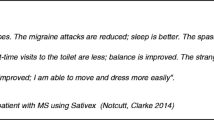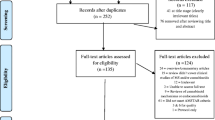Abstract
Anecdotal evidence and preclinical and clinical data indicate that cannabis and individual cannabinoids can suppress muscle spasticity/spasm and pain associated with multiple sclerosis (MS). Anecdotal data come from the responses to a questionnaire by 112 patients with MS who self-medicated with cannabis. The preclinical data come from animal experiments showing that cannabinoid receptor agonists are antinociceptive and can depress motor function, reduce the severity of primary generalised dystonia, and decrease inflammation and the intensity of behavioural signs of experimental autoimmune encephalomyelitis. The clinical data derive from 7 clinical trials, albeit involving small numbers of patients, which indicate that cannabis itself, the cannabinoid Δ9-tetrahydrocannabinol (Δ9-THC) and the synthetic analogue of Δ9-THC nabilone can reduce the intensity of several symptoms in patients with MS or spinal cord injury, including spasticity, pain, tremor and nocturia.
These data provide sufficient evidence to warrant a large scale clinical trial to attempt to provide an objective and conclusive answer to the questions of whether cannabis and cannabinoids are effective in MS and, if they are, whether these effects are achievable at dose levels that do not provoke unacceptable adverse effects. Likely drug candidates for a clinical trial include Δ9-THC and nabilone, both of which are already licensed medicines. When taken orally, Δ9-THC seems to undergo variable absorption and to have a narrow ‘therapeutic window’. This makes it difficult to predict an oral dose that will be both effective and tolerable, so prompting a need for better cannabinoid formulations, cannabinoid vehicles and modes of administration.
There is also a need to establish whether cannabis has any therapeutic advantages over individual cannabinoids such as Δ9-THC and, if so, to investigate the basis for this. In addition, it will be worth seeking out a way of separating the therapeutic properties of cannabinoids from their unwanted effects, particularly their psychotropic effects, and several strategies for achieving this goal are described.
To succeed, any clinical study with cannabinoids will require sufficient funding, the use of adequate outcome measures, and the committed involvement of scientists and physicians who have appropriate cannabinoid and clinical expertise.
Similar content being viewed by others
References
Pertwee RG. Pharmacology of cannabinoid CB1 and CBB2 receptors. Pharmacol Ther 1997; 74: 129–80
Barth F. Cannabinoid receptor agonists and antagonists. Exp Opin Ther Patents 1998; 8: 301–13
Pertwee RG. Cannabis and cannabinoids: pharmacology and rationale for clinical use. Pharmaceut Sci 1997; 3: 539–45
Consroe P, Musty R, Rein J, et al. The perceived effects of smoked cannabis on patients with multiple sclerosis. Eur Neurol 1997; 38: 44–8
Lyman WD, Sonett JR, Brosnan CF, et al. Δ9-tetrahydrocannabinol: a novel treatment for experimental autoimmune enceph-alomyelitis. J Neuroimmunol 1989; 23: 73–81
Richter A, Löscher W. (+)-WIN 55,212-2, a novel cannabinoid receptor agonist, exerts antidystonic effects in mutant dystonic hamsters. Eur J Pharmacol 1994; 264: 371–7
Wirguin I, Mechoulam R, Breuer A, et al. Suppression of experimental autoimmune encephalomyelitis by cannabinoids. Immunopharmacol 1994; 28: 209–14
Pertwee RG. The central neuropharmacology of psychotropic cannabinoids. Pharmacol Ther 1988; 36: 189–261
Martin BR, Thomas BF, Razdan RK. Structural requirements for cannabinoid receptor probes. In: Pertwee RG, editor. Cannabinoid Receptors. London: Academic Press, 1995: 35–85
Calignano A, La Rana G, Giuffrida A, et al. Control of pain initiation by endogenous cannabinoids. Nature 1998; 394: 277–81
Herzberg U, Eliav E, Bennett GJ, et al. The analgesic effects of R(+)-WIN 55,212-2 mesylate, a high affinity cannabinoid agonist, in a rat model of neuropathic pain. Neurosci Lett 1997; 221: 157–60
Richardson JD, Aanonsen L, Hargreaves KM. Antihyperalgesic effects of spinal cannabinoids. Eur J Pharmacol 1998; 345: 145–53
Richardson JD, Kilo S, Hargreaves KM. Cannabinoids reduce hyperalgesia and inflammation via interaction with peripheral CB1 receptors. Pain 1998; 75: 111–9
Smith FL, Fujimori K, Lowe J, et al. Characterisation of Δ9-tetrahydrocannabinol and anandamide antinociception in non-arthritic and arthritic rats. Pharmacol Biochem Behav 1998; 60: 183–91
Kosersky DS, Dewey WL, Harris LS. Antipyretic, analgesic and anti-inflammatory effects of Δ9-tetrahydrocannabinol in the rat. Eur J Pharmacol 1973; 24: 1–7
Sofia RD, Nalepa SD, Harakal JJ, et al. Anti-edema and analgesic properties of Δ9-tetrahydrocannabinol (THC). J Pharmacol Exp Ther 1973; 186: 646–55
Sofia RD, Vassar HB, Knobloch LC. Comparative analgesic activity of various naturally occurring cannabinoids in mice and rats. Psychopharmacologia 1975; 40: 285–95
Meng ID, Manning BH, Martin WJ, et al. An analgesia circuit activated by cannabinoids. Nature 1998; 395: 381–3
Petro DJ, Ellenberger C. Treatment of human spasticity with Δ9-tetrahydrocannabinol. J Clin Pharmacol 1981; 21: 413S–6S
Clifford DB. Tetrahydrocannabinol for tremor in multiple sclerosis. Ann Neurol 1983; 13: 669–71
Ungerleider JT, Andyrsiak T, Fairbanks L, et al. Δ9-THC in the treatment of spasticity associated with multiple sclerosis. Adv Alcohol Subst Abuse 1987; 7: 39–50
Meinck H-M, Schönle PW, Conrad B. Effect of cannabinoids on spasticity and ataxia in multiple sclerosis. J Neurol 1989; 236: 120–2
Martyn CN, Illlis LS, Thom J. Nabilone in the treatment of multiple sclerosis. Lancet 1995; 345: 579
Brenneisen R, Egli A, Elsohly MA, et al. The effect of orally and rectally administered Δ9-tetrahydrocannabinol on spasticity: a pilot study with 2 patients. Int J Clin Pharmacol Ther 1996; 34: 446–52
Maurer M, Henn V, Dittrich A, et al. Delta-9-tetrahydrocannabinol shows antispastic and analgesic effects in a single case double-blind trial. Eur Arch Psychiatry Clin Neurosci 1990; 240: 1–4
Noyes R, Brunk SF, Avery DH, et al. The analgesic properties of delta-9-tetrahydrocannabinol and codeine. Clin Pharmacol Ther 1975; 18: 84–9
Noyes R, Brunk F, Baram DA, et al. Analgesic effect of delta-9-tetrahydrocannabinol. J Clin Pharmacol 1975; 15: 139–43
Jain AK, Ryan JR, McMahon FG, et al. Evaluation of intramuscular levonantradol and placebo in acute postoperative pain. J Clin Pharmacol 1981; 21: 320S–6S
Greenberg HS, Werness SAS, Pugh JE, et al. Short term effects of smoking marijuana on balance in patients with multiple sclerosis and normal volunteers. Clin Pharmacol Ther 1994; 55: 324–8
Agurell S, Halldin M, Lindgren J-E, et al. Pharmacokinetics and metabolism of Δ1-tetrahydrocannabinol and other cannabinoids with emphasis on man. Pharmacol Rev 1986; 38: 21–43
Regelson W, Butler JR, Schultz J, et al. Δ9-tetrahydrocannabinol as an effective antidepressant and appetite-stimulating agent in advanced cancer patients. In: Braude MC, Szara S, editors. Pharmacology of Marihuana. New York: Raven Press, 1976: 763–76
Hollister LE. Health aspects of cannabis. Pharmacol Rev 1986; 38: 1–20
McGuire PK, Jones P, Harvey I, et al. Morbid risk of schizophrenia for relatives of patients with cannabis-associated psychosis. Schizophrenia Res 1995; 15: 277–81
Karniol IG, Shirakawa I, Kasinski N, et al. Cannabidiol interferes with the effects of Δ9-tetrahydrocannabinol in man. Eur J Pharmacol 1974; 28: 172–7
Dewey WL. Cannabinoid Pharmacology. Pharmacol Rev 1986; 38: 151–78
Dalton WS, Martz R, Lemberger L, et al. Influence of cannabidiol on delta-9-tetrahydrocannabinol effects. Clin Pharmacol Ther 1976; 19: 300–9
Perez-Reyes M, Timmons MC, Davis KH, et al. A comparison of the pharmacological activity in man of intravenously administered Δ9-tetrahydrocannabinol, cannabinol and cannabidiol. Experientia 1973; 29: 1368–9
Zuardi AW, Shirakawa I, Finkelfarb E, et al. Action of cannabidiol on the anxiety and other effects produced by Δ9-THC in normal subjects. Psychopharmacology 1982; 76: 245–50
Davis WM, Hatoum NS. Neurobehavioural actions of cannabichromene and interactions with Δ9-tetrahydrocannabinol. Gen Pharmacol 1983; 14: 247–52
Hollister LE, Gillespie HK, Ohlsson A, et al. Do plasma concentrations of Δ9-tetrahydrocannabinol reflect the degree of intoxication? J Clin Pharmacol 1981; 21: 171S–7S
Jones RT. Cannabis tolerance and dependence. In: Fehr KO, Kalant H, editors. Cannabis and health hazards. Toronto: Alcoholism and Drug Addiction Research Foundation, 1983: 617–89
Jones RT, Benowitz N. The 30-day trip — clinical studies of cannabis tolerance and dependence. In: Braude MC, Szara S, editors. Pharmacology of Marihuana. New York: Raven Press, 1976: 627–42
Pertwee RG. Tolerance to and dependence on psychotropic cannabinoids. In: Pratt JA, editor. The biological bases of drug tolerance and dependence. London: Academic Press, 1991: 231–63
Olsen JL, Lodge JW, Shapiro BJ, et al. An inhalation aerosol of Δ9-tetrahydrocannabinol. J Pharm Pharmacol 1976; 28: 86
Tashkin DP, Reiss S, Shapiro BJ, et al. Bronchial effects of aerosolised Δ9-tetrahydrocannabinol in healthy and asthmatic subjects. Am Rev Respir Dis 1977; 115: 57–65
Williams SJ, Hartley JPR, Graham JDP. Bronchodilator effect of Δ1-tetrahydrocannabinol administered by aerosol to asthmatic patients. Thorax 1976; 31: 720–3
Sherman MP, Campbell LA, Gong H, et al. Antimicrobial and respiratory burst characteristics of pulmonary alveolar macrophages recovered from smokers of marijuana alone, smokers of tobacco alone, smokers of marijuana and tobacco, and nonsmokers. Am Rev Respir Dis 1991; 144: 1351–6
Pugh G, Smith PB, Dombrowski DS, et al. The role of endogenous opioids in enhancing the antinociception produced by the combination of Δ9-tetrahydrocannabinol and morphine in the spinal cord. J Pharmacol Exp Ther 1996; 279: 608–16
Pertwee RG. In vivo interactions between psychotropic cannabinoids and other drugs involving central and peripheral neurochemical mediators. In: Murphy L, Bartke A, editors. Marijuana/cannabinoids. Neurobiology and neurophysiology. Boca Raton: CRC Press Inc., 1992; 165–218
Pertwee RG. Pharmacological, physiological and clinical implications of the discovery of cannabinoid receptors. Biochem Soc Trans 1998; 26: 267–72
Pertwee RG, Fernando SR, Griffin G, et al. Agonist-antagonist characterisation of 6′-cyanohex-2′-yne-Δ8-tetrahydrocannabinol in two isolated tissue preparations. Eur J Pharmacol 1996; 315: 195–201
Author information
Authors and Affiliations
Corresponding author
Rights and permissions
About this article
Cite this article
Pertwee, R.G. Prescribing Cannabinoids for Multiple Sclerosis. Mol Diag Ther 11, 327–334 (1999). https://doi.org/10.2165/00023210-199911050-00001
Published:
Issue Date:
DOI: https://doi.org/10.2165/00023210-199911050-00001




